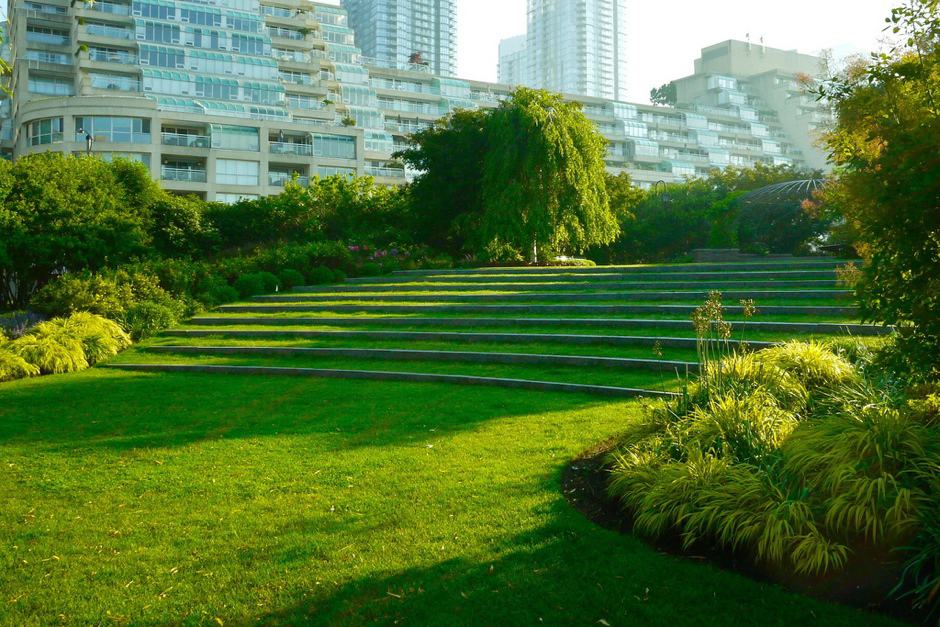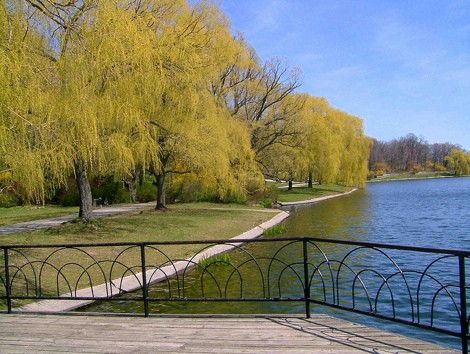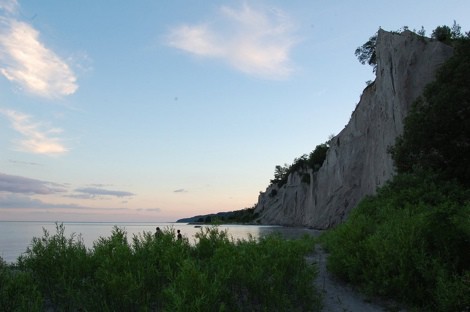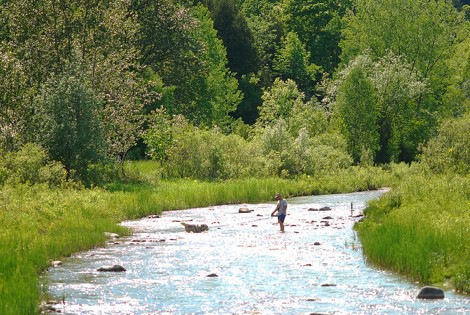While Toronto offers a wealth of summer entertainment, the steady bustle of the metropolis can leave you craving a night under the stars or a quiet walk by the water. Fortunately, Toronto is home to a variety of natural wonders, making it easy to escape the feeling of the urban jungle without really leaving it.
Harbourfront
The Harbourfront is the heart of Toronto’s lakeshore, and is very easy to access from Union Station. Although many parts of the downtown waterside are fairly urbanized, there are still a variety of ways to unwind and connect with nature right in the middle of the city.
Canoeing, kayaking, and paddle-boarding on Lake Ontario are popular options. These activities are fun for beginners and seasoned paddlers, even if you don’t have your own equipment. The most convenient rentals are available on the Queen’s Quay, just south of Union Station, at the Harbourfront Canoe and Kayak Centre. Rental options range from $30 hourly rentals to $70 daily rentals for a single kayak. The centre also offers lessons and guided trips.
For the boat-lover, the Harbourfront Nautical Centre offers sailing lessons and club memberships. The centre also offers power boat and sailboat rentals. The centre is open year round, and lessons and activities, including canoe and paddleboat rides on the Natrel Pond, are available. Boat tours around Lake Ontario are also available.
A unique feature of the Harbourfront is the Toronto Music Garden. Designed by the famous cellist Yo Yo Ma, landscape artist Julie Moir Messervy, and architects from Toronto Parks and Recreation, the garden is based on Bach’s “Suite No. 1 in G Major for unaccompanied cello, BWV 1007.” The garden is located between Queen’s Quay and the Waterfront Trail, and is wheelchair accessible. It offers a great view of Lake Ontario, as well as live music performances. Tours of the Music Garden are available Wednesdays at 11 am and Thursdays at 5:30 pm from June to September. Admission is free. On an average day, the garden is mostly empty, and very tranquil. It offers a peaceful and relaxing atmosphere, perfect for meditation and unwinding from the bustle of the big city.
The Harbourfront is also home to many events by the pier, including cultural festivals and food tastings, various art and photography exhibitions, and the annual International Festival of Authors. Art-related volunteer opportunities are available at these festivals and activities throughout the year with the Harbourfront Centre volunteer programme. Opportunities include assisting as a photographer, event floater, liaison, or programme assistant.
Next to the water are many forest-inspired squares and large, green lawns — great places to sit, relax, and read. Free outdoor tai-chi and yoga are offered weekly from June to August at the Exhibition Common. Free comedy shows, board games, live classical music, and dancing are also available by the water every week this summer. With music, meditation, and various health and wellness workshops, this is a fantastic place to wind down and have fun during lulls in a busy schedule.
High Park
Spanning over 161 hectares, High Park lies in the city’s west end, and is easily accessible by TTC, just steps from High Park station. Though it is famous for its annual cherry blossoms, the park has many other year-round attractions to discover.
In the summertime, High Park boasts diverse vegetation, from interesting flowers to gnarled trees. The Hillside Gardens, a lush expanse of grass stretching from the Grenadier Restaurant down to the lakefront, contains miniature waterfalls and two small bridges, and ends in a giant, maple leaf-shaped floral arrangement at the bottom of the hill. The Grenadier Pond is the main body of water within the park. Fishing is permitted on the south side of the pond, and the observation deck by Hillside Gardens allows for a great view of the reeds, frogs, fish, and fowl. The duck pond is also populated with wildlife; one can often spot geese or swans.
In addition to its natural beauty, High Park is home to a small zoo, with no admission fee, situated at Deer Pen Road. Open from 7:00 am until dusk all year, the zoo contains unique animals, including bison, capybara, deer, and exotic birds.
For those who have been bitten by the summer fitness bug, the park is a great place to be active in a variety of ways. Its fenced-off dog park is the perfect environment for exercise with your pet. There are various fields for Frisbee, kite-flying, or kicking a ball around. Sports facilities in the park include six public tennis courts, a swimming pool, three baseball diamonds, and two soccer fields.
For hikers and runners, the park features lakeside trails, as well as the West Ravine trails, which run through pockets of forest. Biking is permitted on roads and paved trails. The area’s trees provide lots of shade, and make for stunning waterfront views.
The outdoor amphitheatre is a favourite picnic site. The Canadian Stage puts on one or two of Shakespeare’s plays during the annual Shakespeare in High Park event, which has a pay-what-you-can admission fee. This summer, the featured plays are Titus Andronicus and As You Like It. Seats fill up fast, and tickets for reserved seating can be purchased online.
High Park offers many volunteer opportunities through such initiatives as the High Park Volunteer Stewardship program, which is designed to protect, restore, and maintain the natural park environment and The Nature Centre. For a short-term commitment, Colborne Lodge recruits volunteers for specific events throughout the year, especially in the fall. The Friends of High Park Zoo organization also offers volunteer opportunities and activities, including caring for the park’s zoo animals.
Lakeshore
Toronto’s prime location on one of Canada’s Great Lakes provides plenty of seasonal waterfront activities of which to take advantage. The Waterfront Trail, which borders Lake Ontario, is divided into three sections. To the west, the Etobicoke trail is quiet and mostly located near residential areas, with asphalt surfaces that are great for biking. The central Toronto section is optimal for walking , biking, and running by the water. The asphalt path continues for cyclists and skaters, and the boardwalk along the water is perfect for pedestrians. To the east of the city, Scarborough’s Waterfront Trail is made of smaller, off-road trails as well as paved sections through quiet streets.
The lakeshore offers sandy beaches that are perfect for a picnic or a swim. Other spots have large rocks right on the waterline, great to climb for a view of the city skyline. Ponds, grassy parks, and fenced gardens lie just off the boardwalk and paved paths. The Humber Bay Butterfly Habitat is notable among these, as it is home to diverse plants, flowers, and other wildlife. Many bridges overlook the water, where families of swans, cranes, and other waterfowl can be spotted. Bike trails run through areas of denser greenery, offering an escape from the busier main roads.
Aquatic activities include canoeing, kayaking, and the popular dragon-boat racing. Swimming is always a summer favourite, along with sailing and yachting. Lawns and facilities for badminton, lawn bowling, or a game of soccer or Frisbee are available just off the water as well.
The lakeshore also offers its own volunteer opportunities. The Waterfront Regeneration Trust recruits volunteers for trail audits and Waterfront Trail promotions at outdoor shows and events.
Rouge Park & Glen Rouge Campground
Craving a night of camping out under the stars? Rouge Park is 50 kilometres north of Toronto, and is the perfect spot for just that. At over 4,000 hectares, Rouge Park is among the world’s greatest natural parks in an urban setting. Many parts of the park are accessible by public transit, and the campsite is only one kilometre away from the nearest bus stop. Reservations for campsites can be made online and by phone.
Located on the banks of the Rouge River, the park has a wide variety of natural landscapes. It is split into many different sections and reserves, which are accessible to the public.
Biking is permitted on paved roads, and hiking is available on trails that range in their level of difficulty. The shortest routes take around an hour to complete, while the longer ones can take up to a full day. The trails offer a variety of landscapes and views, and most are open all year. Guided tours, many of which are dog-friendly, are available on the trails at select meeting points, accessible by TTC. Plants, flowers, birds, and other wildlife can be found all over the park, and fishing and swimming are both available.
Rouge Park is a great place to enjoy a picnic with friends. Group sites, which include washrooms and shelters, can accommodate anywhere from 30 to 350 people. Unfortunately, no boating equipment is available for rent, but the park is great for a canoe ride if you have your own.
Volunteer opportunities are offered year-round, ranging from single-event to long-term commitments. The Rouge Park monitoring program collects wildlife information, including bird box and bee monitoring. The Educational Stewardship program offers activities to build and preserve wildlife inside the park. Summer-specific opportunities include an insect discovery workshop, an amphibian and reptile awareness day, and a chance to learn about invasive species removal. Opportunities from spring to autumn include birdhouse building and installation and litter clean-ups.





